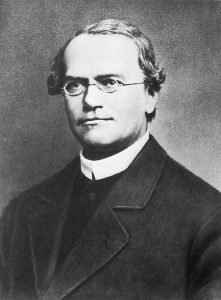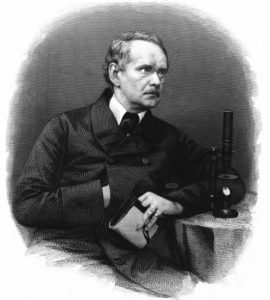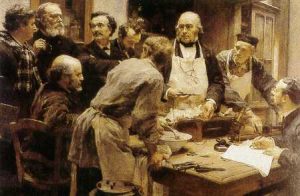—A journey through the origins of biology as a scientific discipline beyond myths and ‘founding fathers’.—
Throughout the nineteenth century, there was an entire series of events that hastened the establishment of biology as an academic discipline. For example, at the beginning of the century authors such as the German botanist Gottfried Reinhold Treviranus (1776-1837) and the French naturalist Jean-Baptiste Lamarck (1744-1829) coined the term ‘biology’, giving it its modern meaning. They did so in two works, both published in 1802: Biologie, oder Philosophie der lebenden Natur (Biology or Philosophy of Living Nature) by Treviranus and Hydrogéologie (Hydrogeology) by Lamarck. In the following years, the elements that make up a particular discipline were developed, such as its own organised content expressed in specific vocabulary responding to certain questions; an institutional territory (research and teaching centres) and, ultimately, spaces whose characteristics can be identified and that favour certain forms of knowledge; its own literature (in the form of journals and textbooks) and thus specific ways of communication; and a collective shared memory in the form of the usual succession of heroes and achievements. The ‘invention of tradition’, an expression which historians such as Eric Hobsbawm used to refer to the political uses of history in nation-building, can easily be transferred to the analysis of disciplines. These, like the nations, are not natural entities but constructed and absolutely contingent.

Gregor Mendel (1822-1884). Museo Virtual de la Ciencia (CSIC).
The content of the biological sciences was assembled on three pillars that are still fundamental today: cell theory, the theory of evolution and, at the end of the long nineteenth century, the theory of heredity. In regard to the latter, it is known that its origin was determined a posteriori in the works that Gregor Mendel developed in the 1860s. However, historical studies have shown that Mendel himself never intended to propose such laws of inheritance. Nor did his peers interpret his work in this sense. However, it is still difficult to establish the specific purpose of his famous research on hybrids. While some historical research considers that the understanding of hybridisation processes was the aim that Mendel pursued, others interpret his work on hybrids as a means to explain ‘evolutionary’ processes, within a tradition that could go back to Carl von Linné. In any case, the link that would be established decades later between the theory of heredity and Mendel’s work does not correspond to historical sources, but rather to the artificial construction of heroes and founding fathers, so common in the institutional consolidation of new scientific disciplines. In reality, the theory of heredity was developed at the beginning of the twentieth century with the work of Carl Correns (1864-1933), Hugo De Vries (1848-1935) and Erich von Tschermak (1871-1962), as well as the contributions of many other authors such as Wilhelm Johannsen (1857-1927), Raphael Weldon (1860-1906) or William Bateson (1861-1926).

Matthias Jakob Schleiden (1804-1881). Wikipedia.
Cell theory, for its part, was largely developed with the revaluation of the use of the microscope and the creation of research spaces within the new German university model. In this institutional model, which is often called Humboldtian, a clearer connection was established between teaching and research. Lecture classes, without completely disappearing, gave way to the seminars and practical work in the laboratory. Those new spaces, allowed the optical instrument manufacturer Carl Zeiss (1816-1888) and the botanist Matthias Jakob Schleiden (1804-1881) to meet, contributing to the technical development of microscopy and overcoming some of the problems produced by the optical abnormalities of previous microscopes. The importance of this contribution is particularly evident if we consider that these abnormalities had substantially devalued the use of the microscope in some areas such as, for example, the study of the animal world. Along with these technical transformations, there were many other contributions that led to the development of cell theory. In this development, the names of a significant number of scientists linked to that German university model appear, such as Jakob Henle, Jan E. Purkinje, Robert Remak and Rudolph Virchow, but especially Jakob Schleiden and Theodor Schwann.
The last two, Schleiden and Schwann, are usually credited with the authorship of cell theory, but historical research has shown that such credit is merely another interested construction based on the hero figure. Today, it is known that Schleiden and Schwann were not the first to put forward the main postulates of cell theory and, in fact, did not even come to completely accept them. Postulates such as ‘all plants and animals are made of cells’ and ‘cells possess all the attributes of life (assimilation, growth and reproduction)’ had already been raised more or less successfully by previous authors. The third postulate ‘all cells come from the division of pre-existing cells’ was not even postulated by them, nor was it ever accepted by Remak and Virchow. Thus, the authorship of the theory is clearly in question and this episode again brings up the real difficulties in assigning ‘authorship’ to theories and ‘paternity’ to disciplines. This highlights the processes of artificial construction operating in the establishment of a collective memory that supports disciplinary identity.
As for the theory of evolution, the essential reference is the publication of On the Origin of Species by Charles Darwin in the mid-nineteenth century. Nevertheless, as the historian Jonathan Hodge warned a few years ago, the traditional accounts of the so-called Darwinian revolution are highly questionable. On the one hand, evolutionary ideas had already been embodied in the works of previous authors, some as well-known as Jean-Baptiste Lamarck himself. However, on the other hand, if evolution is related to a broader concept such as a dynamic view of nature, traces of this approach could even be found in the authors of classical Antiquity. In his critique of the concept of the Darwinian revolution, Hodge proposed the search for another category to define evolutionary ideas and follow their development over a longer historical period. The distinction between static (or fixed) and dynamic (or changing) visions of nature could be useful in this sense. It could help to better contextualise the developments of the nineteenth century and lead to a more nuanced account that would revise the prevailing heroic narrative in textbooks and science communication texts. In this same way, it should also be noted that, if there was a clear rise in evolutionary ideas after Darwin, initially this evolutionism was not eminently Darwinian. In other entries of Knowledge in action, this more complete, and at the same time more complex, vision of the development of the great theories of the biological sciences (such as heredity and evolution) will be taken up again.
Biology also acquired a greater experimental nature through the development of areas such as experimental physiology in the mid-nineteenth century and its emphasis on animal vivisection as a basic method. This change was accompanied by the creation of new spaces, such as the German physiology laboratories, following specific models, as was the case of the laboratory created by Carl Ludwig (1816-1895) in Leipzig. With well characterised spaces such as this laboratory, which soon inspired new laboratories in Germany and North America, as well as in other countries, an approach to physiology that combined vivisection and approaches based on chemistry and mechanics, considered ‘auxiliary sciences’, was encouraged. As seen in other sections and for other disciplines, the new spaces conditioned the types of approaches or questions formulated by the scientific community, as well as the defining parameters of the processes of life studied. Along with the creation of new spaces, there were also other important innovations that contributed to constructing the discipline. At that time, a new rhetoric about the experimental method emerged, driven with particular success by authors such as Claude Bernard (1813-1878) in works such as his Introduction à l’étude de la médecine expérimentale (An Introduction to the Study of Experimental Medicine) (1865).

Claude Bernard giving one of his lectures in 1889. Wikimedia.
The method envisioned by Claude Bernard could be summarised in three stages: observation of phenomena; comparison of observed facts and issue of a hypothetical judgement; experimentation and contrast of the hypothesis with the results obtained. Bernard offered an ideal picture of the experimental method, or of the scientific method in general, which, as in other similar attempts, did not show the complexity of the activities carried out in the laboratory. In fact, it was not even a good reflection of the course of his own research, as the study of his laboratory notebooks by authors such as Mirko Grmek or Frederic L. Holmes has shown. Nor did his reconstruction of the experimental method allow what happened in a laboratory to be distinguished in practice from what happened in other spaces that cannot be identified as scientific or, more specifically, as part of the new experimental biological sciences. However, as is still the case, the ideal of the experimental method portrayed by Bernard was transformed into a rhetorical tool of great value to artificially define the discipline. With all this, biology acquired the distinguishing identity that would allow it to be consolidated as a discipline. Even so, some of the great ‘biologists’ of that century never identified with this new disciplinary identity and, in fact, did not even define themselves as biologists. This was the case, for example, of Charles Darwin.
Ximo Guillem Llobat
IILP-UV
How to cite this paper:
Guillem Llobat, Ximo. Life science. Sabers en acció, 2021-01-25. https://sabersenaccio.iec.cat/en/life-science/.
Find out more
You can find further information with the bibliography and available resources.
Recommended reading
Barona Vilar, Josep Lluís. Història del Pensament Biològic (2a edició). Valencia: Publicacions de la Universitat de València; 2003.
Sapp, Jan. Genesis: the evolution of biology. Oxford: Oxford University Press; 2003.
Richards, Robert. Biology. In: Cahan, David, ed. From Natural Philosophy to the Sciences. Writing the History of Nineteenth-Century Science. Chicago: The University of Chicago Press; 2003: 16-48.
Studies
Barona Vilar, Josep Lluís. Història del Pensament Biològic (2a edició). Valencia: Publicacions de la Universitat de València; 2003.
Bowler, Peter J. Evolution. The History of an Idea, 25th Anniversary Edition. Oakland: University of California Press; 2009.
Duchesneau, François; Kupiec, Jean-Jacques; Morange, Michel. Claude Bernard: la méthode de la physiologie. Paris: Éd. Rue d’Ulm; 2013.
Guerrini, Anita. Experimenting with Humans and Animals. From Galen to Animal Rights. Baltimore: Johns Hopkins University Press; 2003.
Hobsbawm, Eric; Ranger, Terence, eds. The Invention of Tradition. Cambridge: Cambridge University Press; 1983.
Hodge, Jonathan. Against “Revolution” and “Evolution”. Journal of the History of Biology. 2005; 38 (1): 101-121.
Holmes, Frederic Lawrence. Claude Bernard and animal chemistry: the emergence of a scientist. Cambridge (Massachusetts): Harvard University Press; 1974.
Jamieson, Annie; Radick, Gregory. Genetic Determinism in the Genetics Curriculum. An Exploratory Study of the Effects of Mendelian and Weldonian Emphases. Science and Education. 2017; 26: 1261–1290.
Kočandrle, Radim; Kleisner, Karel. Evolution Born of Moisture: Analogies and Parallels Between Anaximander’s Ideas on Origin of Life and Man and Later Pre-Darwinian and Darwinian Evolutionary Concepts. Journal of the History of Biology. 2012; 46 (1): 103-124.
Olby, Robert. Mendel not Mendelian? History of Science. 1979; 17: 53-72.
Radick, Gregory. Lecture “What happens in Mendel’s Paper”. Mendel Symposium. Session I: Mendel and his context. 7 December 2015. Connely Center. Villanova University. Available here.
Richards, Robert. Biology. In: Cahan, David, ed. From Natural Philosophy to the Sciences. Writing the History of Nineteenth-Century Science. Chicago: The University of Chicago Press; 2003: 16-48.
Sapp, Jan. Genesis: the evolution of biology. Oxford: Oxford University Press; 2003.



